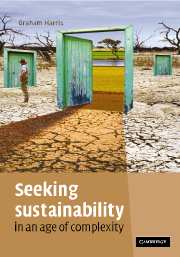Book contents
- Frontmatter
- Contents
- Acknowledgements
- 1 Preamble: the world we are in
- 2 Complexity and complex systems
- 3 New science, new tools, new challenges
- 4 The complexity of ecology
- 5 The generation of complexity
- 6 Micro-interactions and macro-constraints
- 7 A sense of place
- 8 Created landscapes and our changing sense of place
- 9 Catchment form and function
- 10 Catchment loads: ecosystem impacts
- 11 Change detection, monitoring and prediction
- 12 Evidence, uncertainty and risk
- 13 Modified landscapes: biodiversity
- 14 Function in fragmented landscapes
- 15 Environmental flows
- 16 Evidence for global change
- 17 Values and beliefs
- 18 Managing environmental, social and economic systems
- 19 Linking multiple capitals in a changing world
- 20 Community, capacity, collaboration and innovation
- 21 A new environmental paradigm
- 22 Emergent problems and emerging solutions: developing an ‘ecolophysics’?
- 23 Avoiding collapse
- Index
1 - Preamble: the world we are in
Published online by Cambridge University Press: 21 March 2011
- Frontmatter
- Contents
- Acknowledgements
- 1 Preamble: the world we are in
- 2 Complexity and complex systems
- 3 New science, new tools, new challenges
- 4 The complexity of ecology
- 5 The generation of complexity
- 6 Micro-interactions and macro-constraints
- 7 A sense of place
- 8 Created landscapes and our changing sense of place
- 9 Catchment form and function
- 10 Catchment loads: ecosystem impacts
- 11 Change detection, monitoring and prediction
- 12 Evidence, uncertainty and risk
- 13 Modified landscapes: biodiversity
- 14 Function in fragmented landscapes
- 15 Environmental flows
- 16 Evidence for global change
- 17 Values and beliefs
- 18 Managing environmental, social and economic systems
- 19 Linking multiple capitals in a changing world
- 20 Community, capacity, collaboration and innovation
- 21 A new environmental paradigm
- 22 Emergent problems and emerging solutions: developing an ‘ecolophysics’?
- 23 Avoiding collapse
- Index
Summary
From the first members of the human species wandering the African savannahs down to the present day we have witnessed ice ages, extreme events of various kinds and a plethora of cultural, political, historical and other changes. We live in a changing world and it was ever thus. But things are different now. At the beginning of the third millennium we have a nexus of social, economic, technological and environmental trends the like of which has not been seen before. Population growth has brought us to the point where we are the dominant species on this planet, and there is growing evidence of our power to modify the global climate. Human activity is affecting the global biosphere in ever more complex ways as a result of technological development, resource use and industrialisation. We are approaching global constraints on our activities, particularly through our modification of global cycles of energy, water and nutrients. We have unprecedented global connectivity through advanced transportation and telecommunications systems. Our social organisation and our economic activity have grown to the point where we have reached and exploited just about every corner of the globe; so we are now the dominant planetary engineers. In the past thirty years there has therefore been a sea change in our relationship with the planet on which we live. We now have a much more complex and recursive relationship with ourselves and with nature.
- Type
- Chapter
- Information
- Seeking Sustainability in an Age of Complexity , pp. 1 - 18Publisher: Cambridge University PressPrint publication year: 2007

